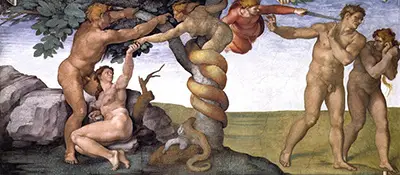When God placed Adam and Eve in the Garden of Eden they were free to do whatever they wished except eat the fruit of this tree. Satan came to them disguised as a snake and tempted them into eating the fruit.
As a punishment, Adam and Eve were no longer welcome to stay in the Garden of Eden and were cast out by an angel. After eating from the tree of knowledge, Adam and Eve became aware of right versus wrong. Eve covers her bosom as she is cast from the Garden of Eden as she has become aware of her nudity. This scene depicts the original sin.
The Fall of Man was painted by Michelangelo on the ceiling of the Sistine Chapel among other visual representations of biblical stories from the Old Testament. He painted the Sistine Chapel from 1508-1512.
Michelangelo was originally commissioned by Pope Julius II to paint a much more modest portion of the church, but Michelangelo created a counter proposal and was granted a free hand to paint what he wished.
Michelangelo's aversion to painting made him reluctant to accept the commission in the first place. In the end, the Sistine Chapel is one of his most well known and appreciated works.
Michelangelo di Lodovico Buonarroti Simoni (1475-1564) is one of the most venerated artists of the Renaissance period. Unlike many artists who only became appreciated after death, Michelangelo's work was appreciated in his time.
He is the first Western artist to have a biography published about him while he was still alive. His contemporaries include Leonardo da Vinci (1452-1519) and Raphael (1483-1520).
The Renaissance style of art moved away from the Medieval penchant for depicting religious figures as other worldly. Artists began to incorporate perspective into their compositions, which made Christian religious figures appear tangible for the first time in art history.
People began to explore themselves as individuals and the field of science began to expand rapidly with this renewed interest in their earthly existence. The High Renaissance refers to a short thirty year period of Italian artistic production, under which The Fall of Man was produced.
This period is marked primarily by grandiose scales, complex compositions, and a renewed interest in classical antiquity.



